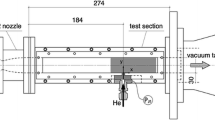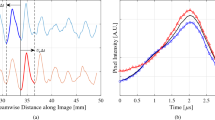Abstract
Three variants of schlieren techniques are employed to investigate the development of second-mode instability waves in the hypersonic boundary layer of a slender cone in a reflected shock tunnel. First, a previously proposed technique using high frame rate (i.e., at least as high as the dominant instability frequency) schlieren visualization with a continuous light source is shown to provide repeatable measurements of the instability propagation speed and frequency. A modified version of the technique is then introduced whereby a pulsed light source allows the use of a higher-resolution camera with a lower frame rate: this provides significant benefits in terms of spatial resolution and total recording time. A detailed picture of the surface-normal intensity distribution for individual wave packets is obtained, and the images provide comprehensive insight into the unsteady flow structures within the boundary layer. Finally, two-point schlieren deflectometry is implemented and shown to be capable of providing second-mode growth information in the challenging shock tunnel environment.




















Similar content being viewed by others
References
Alvin F, Settles G, Weinstein L (1993) A sharp-focusing schlieren optical deflectometer. AIAA Paper No. 93–0629
Casper K, Beresh S, Henfling J, Spillers R, Pruett B (2013a) High-speed schlieren imaging of disturbances in a transitional hypersonic boundary layer. AIAA Paper No. 2013–0376
Casper K, Beresh S, Wagnild R, Henfling J, Spillers R, Pruett B (2013b) Simultaneous pressure measurements and high-speed schlieren imaging of disturbances in a transitional hypersonic boundary layer. AIAA Paper No. 2013–2739
Davis M (1971) Measurements in a subsonic turbulent jet using a quantitative schlieren technique. J Fluid Mech 46:631–656
Demetriades A (1974) Hypersonic viscous flow over a slender cone, part III: Laminar instability and transition. AIAA Paper No. 74–535
Estorf M, Radespiel R, Schneider S, Johnson H, Hein S (2008) Surface-pressure measurements of second-mode instability in quiet hypersonic flow. AIAA Paper No. 2008–1153
Fedorov A, Tumin A (2011) High-speed boundary-layer instability: Old terminology and a new framework. AIAA J 49(8):1647–1657
Fischer M, Weinstein L (1972) Transition and hot-wire measurements in hypersonic helium flow. AIAA J 10(10):1326–1332
Fujii K (2006) Experiment of the two-dimensional roughness effect on hypersonic boundary-layer transition. J Spacecraft Rockets 43(4):731–738
Fujii K, Hornung H (2003) Experimental investigation of high-enthalpy effects on attachment-line boundary-layer transition. AIAA J 41(7):1282–1291
Garg S, Settles G (1998) Measurements of a supersonic turbulent boundary layer by focusing schlieren deflectometry. Exp Fluids 25:254–264
Hannemann K (2003) High enthalpy flows in the HEG shock tunnel: Experiment and numerical rebuilding. AIAA Paper No. 2003–978
Hannemann K, Martinez Schramm J, Karl S (2008) Recent extensions to the High Enthalpy Shock Tunnel Göttingen (HEG). In: Proceedings of the 2nd International ARA Days “Ten Years after ARD”, Arcachon, France
Heitmann D, Radespiel R, Knauss H (2013) Experimental study of boundary-layer response to laser-generated disturbances at Mach 6. J Spacecraft Rockets 50(2):294–304
Hofferth J, Humble R, Floryan D, Saric W (2013) High-bandwidth optical measurements of the second-mode instability in a Mach 6 quiet tunnel. AIAA Paper No. 2013–0378
Johnson H, Seipp T, Candler G (1998) Numerical study of hypersonic reacting boundary layer transition on cones. Phys Fluids 10(10):2676–2685
Kendall J (1975) Wind tunnel experiments relating to supersonic and hypersonic boundary-layer transition. AIAA J 13(3):290–299
Laurence SJ, Wagner A, Hannemann K, Wartemann V, Lüdeke H, Tanno H, Itoh K (2012) Time-resolved visualization of instability waves in a hypersonic boundary layer. AIAA J 50(1):243–246
Mack L (1975) Linear stability theory and the problem of supersonic boundary-layer transition. AIAA J 13(3):278–289
McIntyre S, Settles G (1991) Optical experiments on axisymmetric compressible turbulent mixing layers. AIAA Paper No. 91–0623
Parziale NJ, Shepherd JE, Hornung HG (2013a) Differential interferometric measurement of instability at two points in a hypervelocity boundary layer. AIAA Paper No. 2013–0521
Parziale NJ, Shepherd JE, Hornung HG (2013b) Differential interferometric measurement of instability in a hypervelocity boundary layer. AIAA J 51(3):750–754
Parziale NJ, Shepherd JE, Hornung HG (2014) Free-stream density perturbations in a reflected-shock tunnel. Exp Fluids 55(1665)
Potter J, Whitfield J (1965) Boundary-layer transition under hypersonic conditions. AGARDograph No 97, Part III
Roediger T, Knauss H, Estorf M, Schneider S, Smorodsky B (2009) Hypersonic instability waves measured using fast-response heat-flux gauges. J Spacecraft Rockets 46(2):266–273
Settles G (2006) Schlieren and shadowgraph techniques. Springer, NY
Sivasubramanian J, Fasel H (2012) Growth and breakdown of a wave packet into a turbulent spot in a cone boundary layer at Mach 6. AIAA Paper No. 2012–85
Smith L (1994) Pulsed-laser schlieren visualization of hypersonic boundary-layer instability waves. AIAA Paper No. 94–2639
Stetson K, Kimmel R (1992) On hypersonic boundary-layer stability. AIAA Paper No. 92–0737
Tanno H, Komuro T, Sato K, Itoh K, Takahashi M, Fujii K (2009) Measurement of hypersonic boundary layer transition on cone models in the free-piston shock tunnel HIEST. AIAA Paper No. 2009–0781
van Driest F, McCauley W (1960) The effect of controlled three-dimensional roughness on boundary-layer transition at supersonic speeds. J Aeronaut Sci 27(4):261–271
VanDercreek C, Smith M, Yu K (2010) Focused schlieren and deflectometry at AEDC Hypervelocity Wind Tunnel No. 9. AIAA Paper No. 2010–4209
Wagner A, Hannemann K, Kuhn M (2013a) Experimental investigation of hypersonic boundary-layer stabilization on a cone by means of ultrasonically absorptive carbon-carbon material. Exp Fluids 54:1–10
Wagner A, Hannemann K, Wartemann V, Giese T (2013b) Hypersonic boundary-layer stabilization by means of ultrasonically absorptive carbon-carbon material, part 1: Experimental results. AIAA Paper No. 2013–270
Wartemann V, Giese T, Eggers T, Wagner A, Hannemann K (2013) Hypersonic boundary-layer stabilization by means of ultrasonically absorptive carbon-carbon material, part 1: Computational analysis. AIAA Paper No. 2013–271
Welch P (1967) The use of Fast Fourier Transform for the estimation of power spectra: a method based on time averaging over short, modified periodograms. IEEE T Audio Electroacoustics 15(2):70–73
Acknowledgments
The authors wish to thank the HEG staff, in particular Jan Martinez Schramm, Ingo Schwendtke, Mario Jünemann, and Sarah Trost for assistance in preparing the model and running the tunnel; we are also grateful to N. Parziale for elucidating the FLDI technique.
Author information
Authors and Affiliations
Corresponding author
Electronic supplementary material
Below is the link to the electronic supplementary material.
Supplementary material 1 (wmv 36857 KB)
Rights and permissions
About this article
Cite this article
Laurence, S.J., Wagner, A. & Hannemann, K. Schlieren-based techniques for investigating instability development and transition in a hypersonic boundary layer. Exp Fluids 55, 1782 (2014). https://doi.org/10.1007/s00348-014-1782-9
Received:
Revised:
Accepted:
Published:
DOI: https://doi.org/10.1007/s00348-014-1782-9




